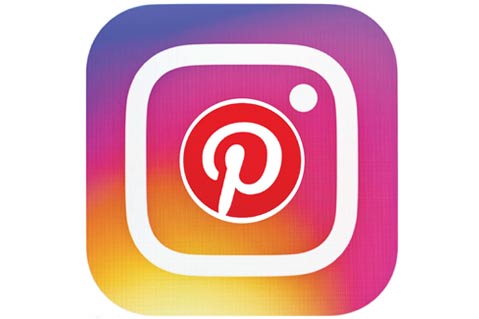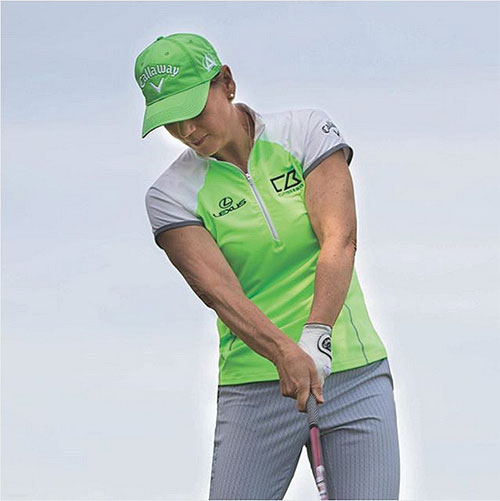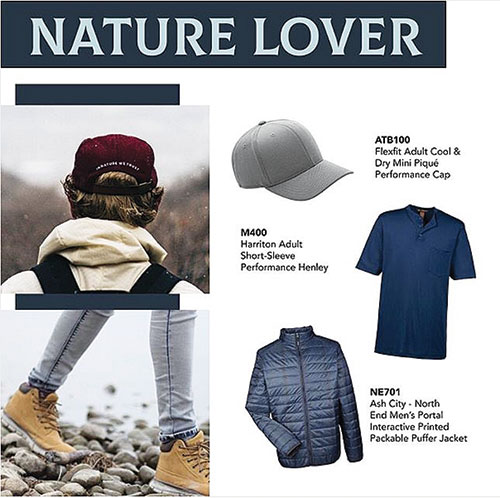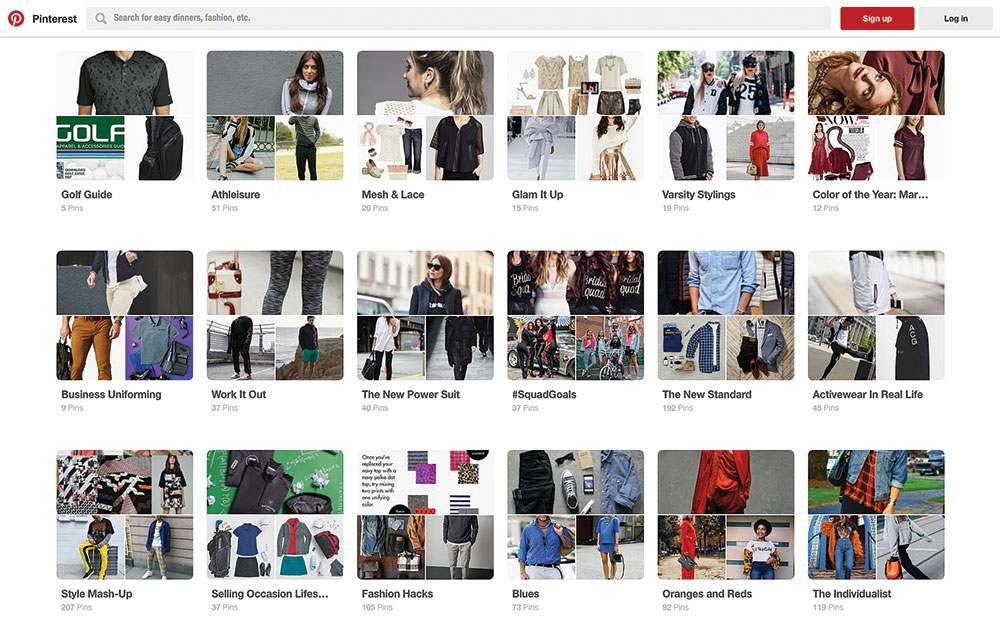July 02, 2018
The Promo Power Of Pinterest And Instagram
Several Top 40 apparel suppliers weigh in on how two popular social networks have become a key part of their marketing mix.
There’s not much that’s more “gramworthy” or “pinnable” than clothes. That’s why some savvy fashion bloggers can make thousands of dollars per post simply for wearing a brand’s clothing. Luckily for the promotional products industry, you don’t need to shell out that much cash in order to productively promote your brand on image-driven social media networks. All it takes is a little bit of ingenuity, hard work and a desire to stay relevant.

Here, five of the industry’s largest apparel suppliers – SanMar (asi/84863), alphabroder (asi/34063), Next Level Apparel (asi/73867), Cutter & Buck (asi/47965) and Tri-Mountain (asi/92125) – dish on the most effective ways to use Instagram and Pinterest to promote wearables.
Get to Know the Networks
Although both Instagram and Pinterest are image-focused, the two social networks have a very different ethos about them. Instagram leans more toward connection, building a network and then hanging out with your new friends online to discuss the #FOMO (fear of missing out) pictures you share. Melissa Zehr Kaufman, marketing communication specialist at alphabroder, picks up the #FOMO vibe, noting that Instagram is about creating emotion through the photography used.
Pinterest, though, is more about spurring creativity.
“With Instagram, we follow the same philosophy we implement across all of our social networks: The purpose of social media is to be social,” says Joshua Storey, SanMar’s web and social media writer. “To that end, we focus less on selling and more on building a community of engaged followers. But Pinterest has a real DIY-vibe going on, which makes it unique. A good majority of our audience browses Pinterest with a specific goal in mind. It’s not really a space to make friends. It’s a place people go when they need to be inspired. ”
The most important thing to remember when deciding what to post on each network is that both have their own style and tone – and it’s decidedly easy to figure out what that mood is. Before you even begin to post, sign up for accounts and lurk for a while. Do some research into what other companies, both within the promotional products industry and the apparel industry at large, are doing and how they’re utilizing those tools. From there, you can figure out your own business’s goal for posting and what you want to accomplish with each interaction.
“Once you’ve picked your theme, it becomes much easier to generate content,” Storey says.
 Cutter & Buck often posts about celebrities who wear their gear.
Cutter & Buck often posts about celebrities who wear their gear.
There’s another major difference between the two networks. Pinterest is much more likely to send a potential customer directly to your website. Instagram is just a compilation of photos with no clickable link; users are meant to virtually swoon over the pretty pictures, hopefully like and comment, and then move on. But with Pinterest, the images themselves are the links. Everything is clickable and (if the pin is set up properly) will take someone right to the website where they can order your product.
Post the Right Stuff
Every apparel supplier Counselor interviewed agreed on one thing: Instagram and Pinterest are essential tools for keeping their brand top-of-mind.
“One of the goals is to keep our products and services at the forefront for customers,” John Perez, marketing associate at Tri-Mountain, says of his company’s social media usage. “We use it as a content marketing tool and customer engagement tool.”
To that point, both networks are an avenue for engagement, allowing customers to not only keep seeing brands pop up in feeds, but also to help build trust and reliability through the posts. In order to do that, it’s essential to post the right content.
Mark Seymour, chief sales officer at Next Level Apparel, considers Instagram in particular to be a great brand promotion tool for the business. “We use it to inform our followers of trade show schedules, promote specific styles, showcase lifestyle videos and photos, inspire our customers and model how to use Next Level Apparel,” he says.
Perez agrees, noting that the bulk of Tri-Mountain’s posts are images and videos for sales, new products and services. Kaufman does the same thing with alphabroder’s accounts, trying to use interesting content instead of just “typical” photography in an effort to spur customers to think outside the box with their apparel in mind.
That’s a critical point – it’s always smart to think about the style of content. What’s the best image to drive the most engagement and, ideally, lead to a purchase?
“Choosing the right image is key,” Storey says. “On Instagram, we’ve found people respond best to peeks behind the scenes and lifestyle photographs. With that in mind, we try to make sure we have people in our photos as much as possible. We do our best to show the apparel in action.”
 alphabroder wins attention on social with themed product collages.
alphabroder wins attention on social with themed product collages.
Subul Sabih, domestic marketing coordinator at Cutter & Buck, has also found behind-the-scenes shots tend to do quite well. Her goal is to make the company both relatable and real. “We’ve started doing stories around our people in the company,” she says. “We’re an apparel company. We’ll always find people wearing the same shirt at the same time for #TwinningTuesday. Those types of posts give us a lot of engagement. We understand the need for customers to get to know you as a company along with your brand.”
Sabih and Business Development Manager Brad Moxley both work to make the Cutter & Buck customer part of the brand’s social story as well. They post customer spotlights, share candids from trade shows, and have even been known to tag a customer in a personalized “we miss you” message when they couldn’t make it out to an event.
“What’s been successful for us is exposing people to what Cutter & Buck is and what their life might be like if they participate in Cutter & Buck as well,” Moxley says.
In terms of content posts, Pinterest is a bit of a different beast. Think of it more like a vision board, something your customers can look at to be intrigued by a certain theme.
“We create boards for each new trend released on The Style Network, and we fill those boards with examples of trending styles made up of our apparel and examples from retail and the fashion industry,” Storey says. “We’ve also been experimenting with boards for our selling occasions, and even filling out more general categories, like boards based on color choice.”
The timing of posts is equally as important as what you post. Your clients need to know they can rely on you to be there as they need you, and a regular posting schedule can help accomplish that.
“At the bare minimum, you want to publish at least one post a week, because you never want someone to come to your account and only see old posts,” Storey says. “Ideally, you’ll post three to four times a week on Instagram and five times per day or more on Pinterest. That can be a tall order when you’re just starting out, but you can use scheduling apps like Buff or Hootsuite to lighten the load. Start small and slowly build up to a more robust content schedule.”
And don’t forget your hashtags. These clickable little phrases and words can bring in tons of followers, especially on Instagram where you can follow specific hashtags, like #promotionalproducts or #apparel. SanMar even has its own hashtag: #EyeSpySanMar.
But overall, remember that Instagram and Pinterest are first and foremost marketing tools. “Always educate, never sell,” Storey says. “Don’t treat your social media accounts like an online catalog. If people want to browse your products, they’ll go to your website. Turn off your sales brain, loosen your collar a little and relax. Folks on social media are looking for a genuine experience, so don’t be afraid to show a little personality.”
Watch Those Metrics
Measuring metrics from these social media networks is incredibly difficult. Both have robust built-in insight panels that show activity, content statistics and audience demographics, but measuring actual engagement can be tricky, particularly with Pinterest.
“Clicks are king on Pinterest,” Storey says. “Due to the way pins are shared, the impression and reach numbers you see are impressively large, but they’re also mostly fluff. If you want to know how well your Pinterest account is really doing, you need to focus on the tangible results – how many people click through to your site.”
Instagram is a bit more black and white. Seymour uses both the built-in analytics and feedback or comments within the platform from customers. Kaufman does something similar, creating an equation that accounts for the number of followers and how they’re responding to posts, be it liking, saving or commenting.
 SanMar’s Pinterest page includes clickable photos and seasonal trends.
SanMar’s Pinterest page includes clickable photos and seasonal trends.
“From there we come up with an engagement rate,” she says. “We tend to focus on overall engagement as a means of success.”
At Tri-Mountain, social staffers use a similar strategy, tracking likes, comments and views. Those views translate into “reach,” or the number of people who are actually seeing a post. At SanMar, the social media team tracks everything with the built-in metrics as well as an Excel spreadsheet. And they pay particular attention to reach.
“We monitor this number on a regular basis, and if we see it going up or down, we adjust our content accordingly,” Storey says. “For example, if I come in on Monday and see that our reach is on the rise, I double down and do more of what we were doing last week. If I see our numbers waning, however, I take a step back and adjust our strategy.”
Cutter & Buck does use metrics software in addition to the built-in metrics to track all its social media engagement. One of the foolproof ways to measure engagement on your posts, Moxley says, is by listening to the people you meet at trade shows and industry events.
“Probably the point where we see the most returns is when we talk to customers,” Moxley notes. “I’ll see them out on the road and they’ll mention the posts they saw on Instagram. I’ve had customers ask me, ‘How can I get that shirt someone was wearing on your Instagram post?’”
One of the biggest conversation starters is Cutter & Buck’s use of celebrities in Instagram photos – like having a golf pro wear one of the company’s shirts in a post during the PGA season. But, Moxley continues, “what we hear the most about is some of the posts that show our daily life at Cutter. We post about our CEO or do Twin Tuesday when two people are wearing the same thing. I get a lot of comments about stuff like that from customers.”
No matter what you post, though, keep it real and use it to complement other promotional drives to get the best returns on your content. That’s one of the biggest rules of social media. “Keep it light,” Kaufman says. “Be creative with your content. Use it as an extension of your already-existing marketing efforts.”
Seymour agrees. “Make it uniquely you, and stay authentic to your brand,” he says, continuing with the most important thing to keep in mind: “Have fun with it.”
They are social networks, after all.
Sharing the Wealth
Follow these tips for the best chances of using supplier content to increase distributor sales.
Brad Moxley, Cutter & Buck (asi/47965): “If we shared something that made you go, ‘Oh, cool,’ think how many of your customers might see it and say the same thing. Share our posts to generate excitement with your customers about things they maybe haven’t been exposed to.”
Joshua Storey, SanMar (asi/84863): “When it comes to our content, consider us a resource. We love to see people repurposing our content and sharing it on their own accounts. If you tag us, we’ll leave a comment, a like, or maybe even re-share your post. This helps boost everyone’s engagement stats and ensures the content gets in front of as many eyes as possible.”